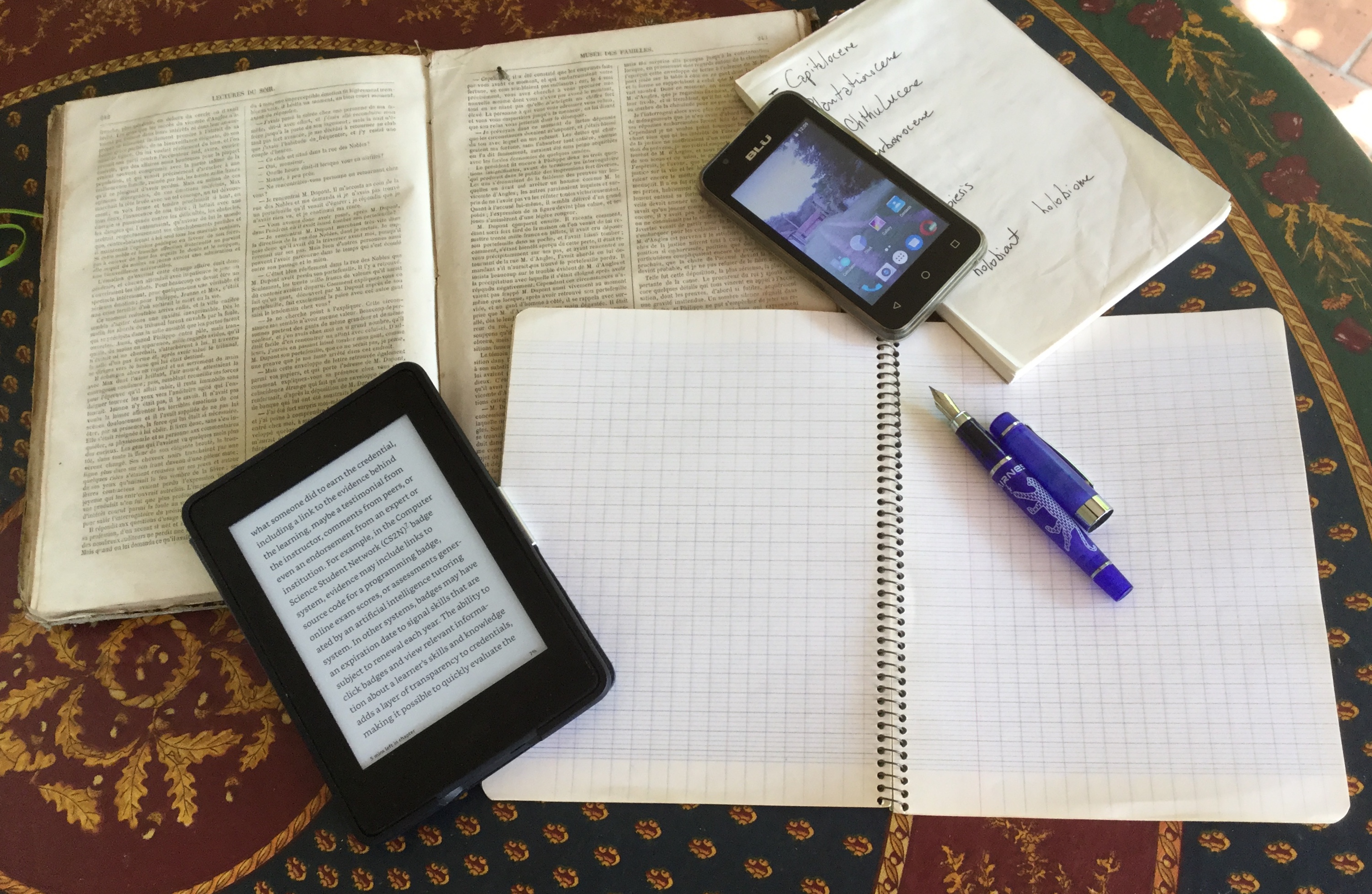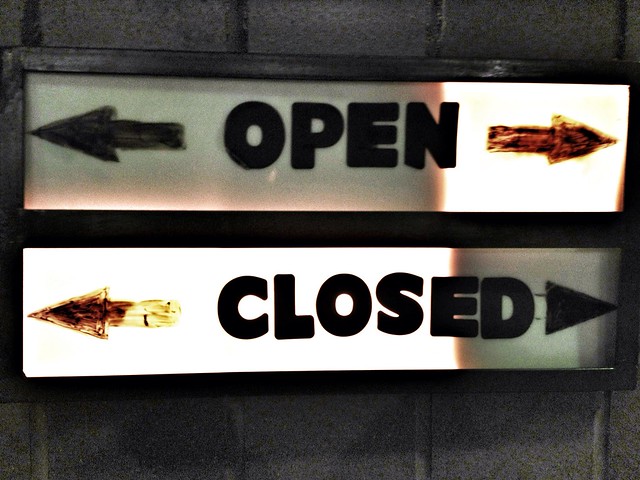[1614 words]
I’m still pondering the relationship between openness and connection. There are significant ways in which the two concepts align well with each other in the domain of learning, even if they do not overlap semantically. That is, open learning is generally characterized by a relative ease of connection in many forms. Let me suggest some examples of potential overlaps or correspondences. Connecting new information or concepts to previous learning. Ease of connecting reflective insights to hard data, or old writing to new writing through easy access to stores of data or to the archive. Connections between learners in different regions or different time zones. Connection and collaboration over great distances. Clearly, “Open” facilitates connection.
There also exist significant ways in which one can also see tension or opposition between the two concepts. One locus of conflict lies in the disciplinary rules for knowledge development and in the parameters that teaching / learning / publishing institutions have developed for verification and control of that intellectual work. Let me offer a brief historical sketch. As humanist intellectual traditions emerged from the Renaissance and evolved through the Enlightenment, the development of ideas and the formulation and verification of mental models and bodies of knowledge took place in a relatively open process. Anyone who felt qualified and able to do so could contribute to the enterprise, which was constructed around the sharing of information, theories and arguments through print media, mostly books. Those media were “accessible” more widely than manuscripts and personal letters and notes had been. However, that “openness” was quite relative. Very few persons could afford to make the steep climb to that “free exchange of ideas.” The participants in the ostensibly open conversation were almost exclusively men. One had to be literate and one had to have the resources to buy or borrow books, assemble a personal library or be in a position to access someone else’s personal library. Additionally, one needed leisure time to read, reflect and write. Finally, one needed a modicum of social-intellectual reputation (a certain kind of social capital) to have access to publication. (Alternatively, one might gain the support and endorsement of an influential patron or a printer through more private channels, but it remains a question of sufficient social capital and intellectual/literary reputation.) Generally speaking, there was no such profession as “scholar” or “researcher.” One could, however, be an erudite writer, like Voltaire or Samuel Johnson and live by one’s pen and by one’s reputation. In the eighteenth century, writers often survived thanks to patronage, but increasingly over the course of the nineteenth century, writers were able to earn a living directly from their writing. That said, even with growing access in the nineteenth and early twentieth century to literacy, coupled with the power of publishing one’s thoughts, theories or research, only those with a certain education and a certain socio-economic standing had access to both learning and the “connected” conversation of the erudite. What is more, that conversation was largely separate from formal systems of education. Indeed, there were few formal systems of education that did not belong to — or that were not controlled by — organized religion.
Over the course of the nineteenth and twentieth centuries, knowledge production, teaching and learning “opened” significantly. The influence of religion in education (and as a moral authority) waned. Secular education, with its somewhat greater freedom of thought and expression, gained in power through state investment and state-sponsored authority; secular institutions gained in influence through the impact and through the scale of new knowledge and perspectives. The secular university also began systematically applying scholarly knowledge and theories to education. It is mostly in the nineteenth century that the scholarly conversation connected with the processes of schooling. At the same time, thinkers increasingly aligned critical inquiry and publishing with disciplinary channels. Areas of knowledge that that had previously been pursued and developed by amateurs and by men of leisure came to be formalized as new secular disciplines, like history, “modern letters,” evolutionary biology, physics.
Openness and connection continued to exist in multiple forms. Indeed, they expanded through relatively accessible channels of publication and knowledge distribution, schools and public libraries, increasingly rapid interpersonal communications. To assure the validity and reliability of information and conclusions that scholar-teachers developed within increasingly well-defined areas of knowledge, those persons (mostly men) certified and authorized each other as experts in particular knowledge domains. The same persons assumed the authority to apply disciplinary rules and criteria to the still generally open discussion of hypotheses, methods, experiments, reflections and conclusions. Over time, scholars and arbiters of publication further clarified and formalized disciplinary rules and criteria.
The authority and prestige of postsecondary institutions increased further. The production of knowledge under their aegis came to be highly regularized. Disciplines and disciplinary academic publications (journals and presses) structured , validated and assured the quality of knowledge production and knowledge dissemination. By the late twentieth century, that that pendulum had swung a bit far in the direction of verification and control (especially control). Disciplinary structure organized most learning, discouraged connection across boundaries and exerted significant influence on the relative prestige and the power of the various discipline-based sectors within universities. (And, as Sir Ken Robinson notes in this TED Talk, around 8:30, the arts fairly systematically find themselves at the bottom of the hierarchy.)
By the 1960s, discipline-focused publication had become an industry unto itself. The very profitability of that enterprise spurred the rise of aggressively for-profit enterprises (publishers, presses, disseminators), who took advantage of the publish-or-perish incentives of academia to harness both relatively inexpensive peer-review labor and large streams of unpaid-for content. Institutional dependence on peer-reviewed publication to evaluate scholars, combined with academics’ need to appear in print (to bolster their h-index or other “scholarly impact” metrics) as a proof of their “productivity” undergird that economic model. [In this phenomenon, I note, the production-oriented capitalist model reshaped the scholarly conversation within the larger evolution of political and economic culture — empire and capital –from the Enlightenment through the mid-twentieth century.
In the last two decades of the 20th century, global capitalism outstripped nation-states and the dominant globalized “knowledge industry” grew to what it is today.] To assure its intellectual production, organizations like Elsevier (“Empowering Knowledge / Knowledge Uncovered“) count on essentially free or very-low-cost academic labor and content. On the flip side of the transaction, those enterprises benefit from lucrative sales because of scholars’ need to consult new research, new writing, new scholarly articles, new books, in short, knowledge products that those firms make available for a somewhat-more-than-modest (or, in some cases, an exorbitant) price, subscription or per-use fee.
There is a paradox here. On the one hand, intellectual work and the production of knowledge are far more democratic and more widely shared in the early twenty-first century than they were in the 1750s. Additionally, modalities of communication now exist that make scholarly communication and the sharing of ideas almost universal and almost instantaneous. The internet has greatly facilitated connection and increased the potential for shared understandings among learners. There is greater openness and greater ease of communication. On the other hand, academic and scholarly controls, increasing “selectivity” and “focus”of some traditional publication channels and extremely expensive conferences tend to push knowledge production and knowledge dissemination in the direction of closure and restriction.
In a very real sense, the rise of disciplines and the enforcement of disciplinary standards in academic publishing has, in significant measure, discouraged cognitive exchange between disciplines and erected barriers to interdisciplinary communication. There are countertrends, of course, that move in the direction of openness and sharing, but the principal thrust in the evolution of scholarship (which influences the organization of learning) has been toward ostensible “rigor” in genre and style among peer-reviewed journals, a “rigor” that discounts modes of expression or formatting that do not align with disciplinary norms, and a restrictive, generally uni-disciplinary focus among journals. Additionally, the economic model that makes access to publications extremely costly also restricts functional openness and ease of connection.
Reaction to what some considered excessive copyright and DRM restrictions, along with rejection of publishing constraints and high fees, led to various openness or open access movements, initiatives, statements or trends, like the BOAI, Creative Commons and SPARC and various open science initiatives. If there is a liberation in these efforts, it is not exclusively in the form of relief from high-cost access to scholarly work, but also in the way in which open online scholarship has rekindled connection across disciplinary lines. Digital humanities, for example, often blends literary or philosophical perspectives with statistical analysis, techniques and models from information science or data visualization. The work of sociologists and literary theorists may appear together, inviting comparison and dialogue. Biologists, geologists and anthropologists may offer converging perspectives on issues like climate change in a single cluster of scholarly pieces. There are ways in which venues that are “open” through ease of access and relatively low cost, also invite “connection,” reviving some of the vigor of the scholarly conversation among erudite polymaths of the Enlightenment, for example, that had been lost.
In the end, I suspect that there will always be a tension between the mindset of some scholars (and, following them, teachers and learners) who insist on disciplinary rigor or on quasi-doctrinal views, on the one hand, and, on the other, the more open mindset, which may include a frank refusal of “restrictive disciplinarity,” of others who do not see the value of allowing their curiosity and intellectual work to be contained within a single well-defined channel or box. It is this latter thought, the refusal of historically emergent but non-essential and somewhat arbitrary constraints and the re-joining of openness and connection in digitally mediated learning and knowledge construction, that gives me hope and that stimulates my passion as a thinker and as a learner.
#openlearning17
-rrdaniel2





